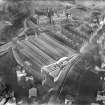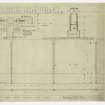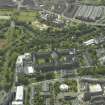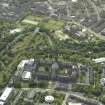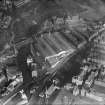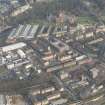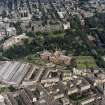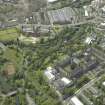Pricing Change
New pricing for orders of material from this site will come into place shortly. Charges for supply of digital images, digitisation on demand, prints and licensing will be altered.
Glasgow, Argyle Street, Kelvin Hall
Exhibition Hall (20th Century), Museum (20th Century), Sports Centre (Modern)
Site Name Glasgow, Argyle Street, Kelvin Hall
Classification Exhibition Hall (20th Century), Museum (20th Century), Sports Centre (Modern)
Alternative Name(s) Bunhouse Road; Old Dumbarton Road; Blantyre Street; Glasgow Transport Museum; Festival Of Britain
Canmore ID 44057
Site Number NS56NE 145
NGR NS 56520 66299
Datum OSGB36 - NGR
Permalink http://canmore.org.uk/site/44057
First 100 images shown. See the Collections panel (below) for a link to all digital images.
- Council Glasgow, City Of
- Parish Glasgow (City Of Glasgow)
- Former Region Strathclyde
- Former District City Of Glasgow
- Former County Lanarkshire
Built in 1926-7 as an exhibition centre, the Kelvin Hall was designed by Thomas Somers, the Glasgow City Engineer. The building is in two sections - the main hall and a block facing Argyle Street, which contains offices. In 1951 the hall hosted Glasgow's exhibition for the Festival of Britain, and in 1984-8 it was converted to become a sports arena and the home of Glasgow's Museum of Transport.
Information from RCAHMS (SC) 16 August 2007
Williamson, E, Riches, A, and Higgs, M 1990
Building Notes (Festival of Britain)
Planned in 1947, the 1951 Festival of Britain was organised and financed by central government. It was made up of a nationwide programme of events that celebrated the British way of life. 187 thematic events ran simultaneously throughout the country. The themes included art, architecture, agriculture, science, industry, music, theatre, religion and the everyday life of the British people.
In 1949 the Festival 1951 Office appointed Basil Spence co-ordinating architect for the Exhibition of Industrial Power, Glasgow and architect of the Sea and Ships pavilion, South Bank, London.
The Exhibition of Industrial Power was held at Kelvin Hall from May to August 1951 and told the story of Britain’s contribution to heavy engineering. Spence worked on the exhibition with a team of five architects including J Hardie Glover (later to become partner in Sir Basil Spence Glover & Ferguson) and Jack Coia. He also commissioned a number of artists including William Crosbie and Thomas Whalen to contribute to the display.
HRH Princess Elizabeth opened the exhibition on 28 May 1951.
Archive Details (Festival of Britain)
The Sir Basil Spence Archive includes a number of contemporary news-cuttings and articles dating from the announcement of the exhibition to its closing. These show how Spence was responsible for the general layout of the exhibition, as well as the detailing of the Hall of Power and the Hall of the Future. The central theme was man’s harnessing of water and coal in order to power heavy industry.
News-cuttings and pamphlets explain that the exhibition was divided into a sequence of six halls. The first was the Hall of Power where the visitor was introduced to the dual themes of water and coal. Two main features dominated the Hall; a vast sculpted mural of a coalface by Thomas Whalen (which was the largest piece of sculpture in the Festival of Britain) and a 20,000-gallon waterfall, which flowed over a glazed walkway. The final hall was the Hall of the Future. This included a 1,000,000-volt lighting machine that was used to explain the theory of nuclear fission and a mural by William Crosbie depicting nuclear power.
Archive Summary (Festival of Britain)
The Sir Basil Spence Archive holds a framed perspective of the Hall of Power, one manuscript folder, 61 contemporary news-cuttings, 36 photographs and 56 drawings relating to the Exhibition of Industrial Power. The drawings include sketch details and figure studies by William Crosbie. The Spence Glover & Ferguson Collection, also held by RCAHMS, contains 61 black and white photographs of the exhibition.
This text was written as one of the outputs of the Sir Basil Spence Archive Project, supported by the Heritage Lottery Fund, 2005-08.
Building Notes (Scottish Industries Exhibition)
The Scottish Industries Exhibition (SIE) was organised by the Scottish Council (Development & Industry). It was held at Kelvin Hall, Glasgow 1 -18 September 1949. Basil Spence was commissioned as its Architectural Advisor with Hardie Glover as assistant. The SIE was the biggest trade fair held in Scotland after the end of the Second World War. Unlike the 1947 Enterprise Scotland Exhibition (where the exhibits were not available for purchase to the general public), all exhibits in the SIE could either be ordered or purchased by the general public.
Basil Spence and Partners designed ten exhibition stands. These were for Scottish Council (Development and Industry), Council of Industrial Design (CID), ICI, Wylie & Lochhead, Morris & Co Ltd, J & P Coats, BOAC/BEA, Distillers Co Ltd, Babcock and Wilcox Ltd, and James Templeton Ltd.
The exhibition was opened by HRH the Queen Mother and Princess Margaret, on 1 September 1949.
Archive Details and Summary (Scottish Industries Exhibition)
The Sir Basil Spence Archive holds five presentation drawings, plans, sections and elevations, for the ICI and Distillers Company, 36 photographs and one manuscript folder containing news cuttings.
The Archive includes a presentation drawing by Basil Spence for the Wylie and Lochead exhibition stand. This shows a carousel with conical roof, draped in ribbons topped with a sphere. Photographs in the Archive of the Wylie and Lochead stand at the exhibition show that the finished stand was very different to Spence’s early scheme. It was square in plan, with a flat roof supported on simple slender columns and open on three sides.
The Sir Basil Spence Archive also holds three photographs of the 1954 Scottish Industries Exhibition held at Kelvin Hall. These show a plan, section and elevation of the Ferranti exhibition stand and two views of the Ferranti stand during the exhibition.
The Spence Glover and Ferguson Collection, also held by RCAHMS, contains 61 photographs of the 1949 Scottish Industries Exhibition.
This text was written as one of the outputs of the Sir Basil Spence Archive Project, supported by the Heritage Lottery Fund, 2005-08.
NS56NE 145 56520 66299
Kelvin Hall [NAT]
OS 1:1250 map, 1971.
NS56NE 145 56520 66299
New Museum of Transport: for former tram depot and old Museum of Transport see NS56SE 198.
Construction (1926 - 1927)
Display (1951)
Festival of Britain. Kelvin Hall held an exhibition on Industrial Power.
Field Visit (October 1998)
Aerial Photography (31 May 2006)
Directed towards collecting views of Glasgow in support of a 'Glasgow from the Air' volume. The newly completed Wishaw General Hospital and the disused Law Hospital near Carluke were also recorded. A patch of rig was recorded as soilmarks near Cumbernauld. A possible later prehistoric settlement enclosure beside Glasgow airport, seen for the first time as a cropmark in 2005, was recorded again, also as a cropmark.
































































































































